
Wine Culture and Information since 2002 - Volume 22
 Wine Culture and Information since 2002 - Volume 22 |
|
Issue 29, April 2005 |
Contents |
|
|
Prejudices About Wine |
|
Wine - and this is something the many connoisseurs of the world know very well - is an extremely rich beverage, capable of offering countless interpretations according to the many factors regulating its production. Also thanks to its millenary history and to the wide spreading of the vine in the world, every country is capable of producing wines with unique characteristics - either good or bad - while offering to the consumers different emotions and sensations according to the environmental and meteorological conditions of the year. This is also what happens - in general terms - when the emulation of other countries' styles is avoided therefore offering in the glass of wine lovers the culture, tradition and richness of every country. After all, this is also what makes wine so interesting and amazing: no matter the country you go, the wine is always different. This is also what we all wine lovers wish ourselves, in the hope to avoid a future where the production of wine is made with the very same “model” and having the same taste, as well as avoiding a future made of wines all the same, all similar to each other. Nowadays wine subject is very common, also supported by the fact that around this beverage has been developed a wide popular interest - and therefore important commercial and economic interests - and it is considered as a “trendy” subject and, luckily, the attention of most of the consumers is paid on quality instead of quantity. The many labels today available in the market - from wine shops to malls - confirms the commercial importance of wine and if ten years ago malls dedicated a modest area to wine, today are being dedicated whole sectors while offering their customers a wide selection. This is also the sign of an important change, because no one - at least up to ten years ago - would have never believed to see in malls' shelves renowned, expensive and valuable labels: today this is seen as a normal fact, one of the many ways to reach consumers while achieving the ultimate goal of production: selling and therefore profits. However in the world of wine - although it would be better to say in the world of wine consumers - there are many prejudices and behaviors of strong skepticism towards some wines and some categories of wines. This kind of behaviors are very hard to change among consumers, most of the times - it should not be forgotten - are caused by efficient advertising and marketing campaigns which strongly influence the choices of consumers, or at least a good part of them. It should be recognized these prejudices are frequently justified by evident reasons and therefore objectively agreeable, whereas there are others which are caused by disputable conditions of the past and, despite things are changed for good, prejudices and skepticism towards some products do not change at all or however are hard to change. For example, everyone can recall the endless debate which goes on since many years about Champagne and Italian sparkling wine. A competition which is going on since tens of years and which is mainly based on some conditions of the past, which are now so strong, even though things have changed. Italian sparkling wine has evolved and its quality is today very high, nevertheless there are many consumers out there who disregard any kind of bubbles with the exception of the ones coming from the noble Champagne. Of course Champagne is a unique and extraordinary wine - who can deny this - but the same can be said today about other sparkling wines, including Italian Spumante. However the prejudices and skepticism towards this kind of products is pretty high and many consumers keep on supporting these ideas - tens of years old - even without having never tried with their nose and with their mouth the radical change which has developed in the course of the years. Even worse, many make use of prejudices because they heard someone saying what it is better and what it is worse, without having checked this out themselves. There also are prejudices caused by bad experiences and that are implicitly applied to any similar and future experiences. There are many who after having tasted a mediocre or bad quality wine, believe that all the wines belonging to the same category have the same quality and therefore are scrupulously avoided. There are people - and we do certainly not have the presumption of criticizing their tastes and preferences - that after having tasted a bad quality white wine, reject the idea of tasting any other white wine just for the fact it belongs to the category offended by a bad quality exemplar. Most of the times these people end up considering red wines only and they usually believe they are the only and worth representatives of the beverage of Bacchus. Whoever considers himself or herself a wine lover knows there are many white wines out there capable of shadowing a pretty wide group of red wines. The same can be said for any other wine style, of course. Things are of course different in case someone does not like a particular wine just because it does not meet his or her taste: this is something no one can criticize or object. What can be criticized are the behaviors in which are being indiscriminately used ridiculous prejudices and skepticism of past times. What makes wine so interesting is also this: the possibility of having a wide selection of products which are waiting to be evaluated and each of them capable of denying or confirming any prejudice or skepticism. The conclusion is however the same, so similar to what happens in human relationships as well. There are people who are capable of listening even in case they do not agree on others' ideas and have the will to understand, others that, not only are incapable of listening, but keep on talking arrogantly while not allowing others to express their opinions. The same is true for wine. If we allow it to talk and to express itself by means of its aromas and tastes, we will understand it fully and we will benefit from its history and culture. If we do not even allow it to talk, we cannot pretend to understand. The fault is not of that wine we denied our attention because of a prejudice which makes poor the one who allows it to make him or her blind.
|
||||
MailBox |
|
In this column are published our reader's mail. If you have any comment or any
question or just want to express your opinion about wine, send your letters to
our editorial or fill in
the form available at
our site.
|
| In many bottles of sparkling wines and Champagne, the disgorgement date and the vintage is never stated. Are these information included in the codes usually found in the labels? Thank you for your reply and congratulations for the site. |
| Giuseppe Scattolin -- Padua (Italy) |
| The disgorgement date and the vintage in classic method sparkling wines - such as Champagne and Franciacorta - are sometimes omitted in labels. Whereas the disgorgement date should be written in the label - in the sake of clearly stating the characteristics of a wine and not because it is mandatory - the exact vintage of a sparkling wine is not always determinable. The base wine used for the production of classic method sparkling wines and defined as sans année or non vintage, is generally obtained by blending many wines produced in different years, therefore it would not make much sense talking about a specific vintage. Concerning the codes usually written in Champagne labels, we suggest you reading the article Champagne published on the issue 22, September 2004. |
| A friend of mine says that in extra brut and pas dosé sparkling wines, before the refermentation in bottle takes place, is being added a mixture containing yeast only. I think he is not right as with no sugar the refermentation process would not be possible and no carbon dioxide would be produced. Who is right? Congratulations for your magazine. Good job. |
| Luigi Fasano -- Livorno (Italy) |
| As you rightly observed, the refermentation in bottle for classic method sparkling wines is obtained thanks to the presence of sugar added to the mixture and, because of the effect of yeast - present in the mixture as well - it makes the refermentation possible. This mixture - called liqueur de tirage - is made with the base wine to which is added a certain quantity of sugar and selected yeast. This mixture is added to every type of sparkling wine - no matter the production method - and no matter the sweetness of the finished product; it is therefore used for the production of extra brut and pas dosé as well. The sugar added to this mixture will start the refermentation in bottle with the result of producing carbon dioxide - responsible for effervescence - as well as alcohol. To know more about sparkling wines production, we suggest you reading the article Production of Sparkling Wines published on the issue 22, September 2004. |
VenetoAmarone, Recioto, Soave, Prosecco: just few names of wines renowned all over the world and which are from the very same northern region in Italy, among the main wine producing areas of the country |
|
Veneto is one of the main Italian regions in terms of quantitative production of grape, the wines produced in this region are famous in every country of the world. Amarone, Recioto, Soave, Prosecco, Valpolicella and Bardolino, are just few names known all over the world and in most of the cases they do not only identify Veneto's wine but also the Italian one. The most interesting characteristic of Veneto is certainly represented by the fact the success of its wines is mainly determined by the many autochthonous grapes cultivated in the region, both white and red. Garganega, Trebbiano di Soave and Prosecco are among the main grapes used for the production of white wines; Corvina, Rondinella, Molinara and Raboso are the ones mainly used for the production of red wines. The enology of Veneto has a wide ampelographic wealth and territorial differences allowing a production of wines having many qualities, from light and crisp wines up to the most robust and full bodied ones, such as Amarone. The history of wine in Veneto - just like any other Italian region - begins in very ancient ages, far before the times of Greeks - to whom is usually recognized the introduction of vine in Italy - as it is widely proven by important archaeological discoveries. It is believed vine was present as a wild plant in Veneto since many centuries before Christ and grape was used by the people of those time as a food. The first evidences about wine production in Veneto are dated back to the seventh century BC by the Etruscan-Raetic people, in particular Arusnati. The first important written information about the production of wine in this area are dated back to Roman times, when the wines from Raetia were praised for their qualities. The renowned Raetic wine - produced with Raetic grape - was praised by important authors of the past such as Columella, Celso Aulo Cornelius, Martial, Strabone, Suetonius, Pliny the Elder and, in particular, Virgil who believed this wine to be second only to the famous Falerno.
Another important wine particularly famous after the fall of the Roman empire was Acinatico, a sweet wine which can be considered the real ancestor of Recioto di Soave, Recioto di Gambellara and Recioto della Valpolicella. It was a sweet wine produced with grapes dried on mats and subsequently vinified. Acinatico was so appreciated that Flavius Magnus Aurelius Senator - also known as Cassiodore and mininster of the Ostrogothic king Teodoricus - has left his witness in a writing where he described the qualities of this wine and his highest appreciation. Despite Barbarian people who invaded these lands appreciated these wines, they were also responsible for devastating most of vineyards. It was only in 643 AD the vineyards of Veneto were for the first time and by law protected by a special edict. The Longobard king Rotari promulgated an edict which set penalties to anyone responsible for vineyards damages or was responsible of stealing grapes. Similar edicts have been promulgated in later times, the cultivation of vine was widely favored and its spreading was so high which also reached the inside walls of many cities. During the Middle Age, the development of viticulture and wine making in Veneto was also determined by the commercial power of Venice, which does not only favored the exportation of Veneto's wines in other countries, it also favored the introduction of foreign wines, in particular the ones from Greece and Cyprus. Venetian merchants - besides importing wine - also introduced new vine species, while promoting its spreading in the neighboring territories, such as Malvasia that from Venice has spread in Friuli Venezia Giulia and Dalmatia. Even the famous glass makers of Murano contributed to the spreading of wine and its best appreciation. The refined bottles and glasses from Murano rapidly spread in the tables of noble people therefore replacing earthenware, silver and pewter containers. The new glass containers were associated with quality wines and in a short time - in simpler and less valued shapes - reached the tables of the common people all over Europe. With the decay of the commercial power of Venice in the Mediterranean area and in particular in the Eastern countries - around the half of 1500's - the import of Greek wines was drastically reduced while offering an opportunity of development for local wines. It began in this period the fame of the wines from Treviso, Vicenza and, of course, the Valpolicella area. During the sixteenth century the destiny of Veneto's wine was characterized by periods of high appreciation as well as of decay, in particular because of devastations caused by wars and pestilence. In 1709 was recorded an incredible cold season which - because of frosts - destroyed most of vineyards, an event which dramatically changed the viticulture in Veneto. After this catastrophic event the viticulture of Veneto was approximate and the production of wine faced the same destiny. It was only in 1800's that was recorded an attempt in order to start a new development of Veneto's enology by studying the characteristics of the territory and of the grapes which were best suited: a first and important step towards the rebirth of quality. Despite these new attempts, other dreadful catastrophes were about to happen, not only in Veneto, but all over Europe. Around the half of the 1800's, with the advent of oidium, began a new dark era for viticulture, followed by mildew and then phylloxera. These unlucky events did not influence the impulse towards the rebirth of Veneto's enology which was started in the past years. In 1876 was established the renowned School of Enology of Conegliano and in 1923 the Experimental Station of Viticulture and Enology. Thanks to the studies and the efforts of these two important institutes, it was possible to give a strong impulse to Veneto's enology towards the challenge of the 1900's which also favored the introduction in the region of international grapes, an event which did not affect the spreading of local grapes. After the 1950's - in Veneto as well as in other Italian regions - began a new future for enology and everyone understood the strategical importance of quality: a process which has strongly developed during the 1990's and still today is in progress.
|
||||||||||||
|
Wines produced in Veneto are classified according to the quality system in force in Italy. The highest level of this system is identified as DOCG (Denominazione di Origine Controllata e Garantita, Denomination of Controlled and Guaranteed Origin) which includes a higher classification in case it is mentioned the subarea of production. The following levels are DOC (Denominazione di Origine Controllata, Denomination of Controlled Origin), IGT (Indicazione Geografica Tipica, Typical Geographic Indication) and Vino da Tavola (Table Wine). In Veneto are currently defined the following DOCG areas: Bardolino Superiore, Recioto di Soave and Soave Superiore. The current DOC areas of Veneto are: Arcole, Bagnoli, Bardolino, Bianco di Custoza, Breganze, Colli Berici, Colli di Conegliano, Colli Euganei, Gambellara, Garda, Lison-Pramaggiore, Lugana, Merlara, Montello-Colli Asolani, Monti Lessini, Piave, Prosecco di Conegliano-Valdobbiadene, San Martino della Battaglia, Soave, Valdadige, Valpolicella and Vicenza.
|
|
The most renowned red wines of Veneto are the ones produced in Valpolicella (also known as Valpantena) of which the most representative one certainly is Amarone. This wine - rich, complex and strong - is generally produced with Corvina, Rondinella and Molinara grapes. Amarone is produced with dried grapes - just like Recioto - which after been vinified give a strong and concentrated wine. Whereas Amarone is a dry wine, Recioto contains some residual sugar which determines its sweetness. Amarone can be considered as a wine derived from Recioto, usually defined in Valpolicella as a Recioto scapà - a dialectal form meaning fled Recioto - like to say a Recioto which was fermented too long. Famous is the ripasso (to pass again) technique used to give more body to Valpolicella red wines. This technique consists in pouring a red wine in the pomace of Recioto or Amarone, therefore giving the wine a higher quantity of aromas and a fuller body and - in case of Recioto pomace - a certain quantity of sweetness as well. Valpolicella's red wines are mainly produced with the same grapes used for Amarone and Recioto.
|
|
The Conegliano area, and in particular Valdobbiadene, is famous in the world for the production of sparkling wines made with Prosecco grape. The celebrity of these sparkling wines is so high that sometimes the term Prosecco is believed to refer to the specific name of the wine or to its sweetness. Indeed Prosecco is the name of the grape used for its production and whose origin is from Friuli Venezia Giulia region. Sparkling wines from this area are produced with the Charmat method - or Martinotti method - very suited to the exaltation of the aromatic qualities of Prosecco grape. Particularly appreciated is the Prosecco Superiore di Cartizze which is named after the homonymous area near San Pietro in Barbozza, in the commune of Valdobbiadene. The territory of Prosecco Superiore di Cartizze has an acreage of about one hundred hectares (about 250 acres) in which are being produced more than one million of bottles. Prosecco - besides being produced in many sweet versions - is also produced in slightly sparkling version and tranquillo, that is vinified according to the usual wine making techniques in order to get a still dry wine.
|
|
The most famous white wines of Veneto certainly are the ones produced in the Soave area, near Verona, in which is found the highest expression of two famous white berried grapes of the region: Garganega and Trebbiano di Soave. The classic production area includes two communes only - Soave and Monteforte d'Alpone - and here are being produced the best white wines of this DOC area. This production area also includes a denomination of controlled and guaranteed origin (DOCG) exclusively reserved to Soave Superiore wines. Besides dry table wines, the Soave denomination also produces sparkling wines, both classic method and Charmat. The first wine - and therefore the first wine area - to which was recognized the first DOCG of Veneto is Recioto di Soave. This wine is produced with grapes allowed to dry for about six months - mainly Garganega - and then vinified. The result is an interesting sweet wine in which it is possible to recognize pleasing aromas of dried apricot, citrus fruits and honey, an enchanting wine perfect for confectionery and that can be appreciated alone as a meditation wine.
|
|
One of the most interesting areas in the province of Padua certainly is Colli Euganei. In this area are being produced interesting wines - white, red and sparkling - however the most interesting one is Fior d'Arancio (Orange Blossom), in particular its sweet version, produced with Moscato Giallo (Goldmuskateller). In this area is also produced an interesting wine - Serprino - with Prosecco grape and of which the most typical style is slightly sparkling. The red wines of Colli Euganei are generally produced with international grapes such as Merlot, Cabernet Sauvignon and Cabernet Franc, as well as Raboso and Barbera. For the production of white wines are generally used the grapes Tocai Italico, Pinot Blanc, Muscat, Garganega, Riesling, Sauvignon Blanc and Pinello. The wine area of Breganze - in the province of Vicenza - offers a valuable production of white and red wines and - in particular - the excellent and renowned Torcolato. Even in this area are being cultivated international grapes - with which are being produced both white and red wines - however the most characteristic variety of this area is Vespaiolo. With this grape variety are produced interesting white dry wines, however its best expression is obtained after a proper drying and from which is produced the renowned Torcolato, a wonderful sweet wine appreciated worldwide.
|
|
Many of the areas recognized as denomination of controlled origin in Veneto have made famous the enology of the region and of Italy in the world. Among them is certainly included Bardolino, whose wines are generally produced with the same grapes of Amarone, however having a lesser structure and character. In this area is also produced the Bardolino Superiore to which is recognized the DOCG status. Another renowned white wine from Veneto is Bianco di Custoza - of which in recent times is also allowed the production in the sparkling and sweet styles - made with the grapes Trebbiano Toscano, Garganega, Tocai Friulano, Cortese, Riesling Italico, Pinot Bianco, Chardonnay and Malvasia Toscana. Particularly interesting is the production area of Gambellara and in particular the Recioto di Gambellara wine - produced with Garganega grape - as well as the rare Vin Santo. Veneto shares three DOC areas with the neighboring Lombardy and from which are produced interesting wines: Lugana, San Martino della Battaglia and Garda. A particular mention goes to Raboso - protagonist of the Piave wine area - a grape rich in tannins and acid from which are being produced interesting and robust red wines.
|
SémillonMost of the times the name of this grape does not say anything to many, but once its most renowned wine is mentioned - Sauternes - for every wine lover becomes the synonym of great elegance, class and value |
|
Sauternes - the famous sweet wine produced in the homonymous Bordelais city - is considered by connoisseurs among the best sweet and botrytized wines of the world, however not anyone know that behind this famous wine is “concealed” Sémillon - a white berried grape not very common in the world - and which is responsible for a good part not only for Sauternes, but also for other similar wines of this area. Barsac and Monbazillac are just two examples of great sweet and botrytized wines produced with Sémillon, however - to tell the truth - the fame of these products is also because of the quality of Sauvignon Blanc and Muscadelle, frequently blended with Sémillon for the production of these wines. Despite Sémillon is the main component of the most renowned sweet wines of the world, its spreading in other countries has never been wide, and only in few other areas of the world acquired a certain importance in local viticulture, such as in case of Hunter Valley, Australia. Sémillon - usually written as Semillon in non Francophone countries - originated from the south-western area of France where until the end of 1960's represented the most cultivated white berried grape of the region. The territory in which this grape is currently most common is Bordeaux, in particular the areas of Graves, Sauternes, Barsac and Entre-Deux-Mers. In these areas Sémillon is frequently used for the production of wines together with Sauvignon Blanc, such as in case of Sauternes wines. This blend - which is not simply forced by the ampelographic conditions of the area - represents an ideal condition in order to have a good balance in these white wines. Sémillon does not have rich aromatic qualities and its acidity is pretty low, however it gives full bodied white wines with intense colors. In this sense Sauvignon Blanc seems to be its ideal and complementary companion, as it has a strong aromatic quality as well as a high acidity and generally gives light bodied wines. The result of the blending of these two grapes usually gives pretty interesting wines.
The qualities of Sémillon can be considered according to many aspects because of the use made in enology for the production of different wine styles. Besides the exception represented by the wines produced in the Hunter Valley - Australia - the use of Sémillon for the production of mono varietal wines gives products with pretty anonymous and light aromas. The use of cask - that Sémillon seems to accept pretty well - adds the classic tertiary aromas while giving the wine a longer life in the aging in bottle. In the production of dry table wines, the most interesting result is the one obtained by the blending with Sauvignon Blanc, a very frequent combination especially in the Bordeaux area and adopted in other countries as well. What makes Sémillon a prestigious nectar is its high sensitivity to the effects of Botrytis Cinerea - the famous noble rot - as its thin skin facilitates the penetration of this mushroom inside the berry. The result is magisterially represented by the best examples of the wines from Sauternes, Barsac and Monbazillac, styles of botrytized wines which are usually imitated in many parts of the world. According to a viticultural point of view, Sémillon is a grape which easily tends to overproduction, a characteristic which requires a scrupulous pruning and that however ensures copious harvests for the production of mediocre quality wines. Mature Sémillon berries generally have a deep golden yellow color which turns into an almost pink color when overripe, a quality which is responsible for the intense colors in its wines. Sémillon is a pretty simple grape to cultivate and it generally adapts itself in many types of soils, however the best results are obtained in clay and limestone as well as in marl and gravelly soils. Sémillon is particularly sensitive to the effects of Botrytis Cinerea, which can also represent a serious danger - in particular in the areas with unfavorable climate and meteorological conditions - as it easily tends to get rotten, however it is very resistant to all the other vine diseases. Sémillon is a grape with a modest content in acid and the alcohol level of its wines can be considered as medium-high. This characteristic is mainly found in warm climate areas in which is also added an appreciable structure. For this reason very good quality wines produced with plain Sémillon are pretty rare while justifying the typical use of this grape together with Sauvignon Blanc. The best examples of use of plain Sémillon are the ones from the Hunter Valley - Australia - as well as some sweet wines produced in the area of Sauternes, even though in most of the cases the composition of these renowned wines includes Sauvignon Blanc and Muscadelle. Wines produced with Sémillon grape certainly express their best qualities after a proper aging in bottle and - as opposed to the majority of white wines - it can also reach more than ten years, such as in case of Sémillon wines produced in the Hunter Valley. It is always advisable to allow quality table wines produced with Sémillon to age in bottle for at least four years. Longevity of sweet wines produced with this grape - such as Sauternes and Barsac - benefits from the higher quantity of sugar and therefore can also reach many tens of years.
|
||||||||
|
Wines produced with Sémillon - of any style - always show very intense and deep colors. When Sémillon grape reaches its optimal ripeness, the color of its skin gets deep golden hues, which will turn into evident pink nuances when overripe, just like for Gewürztraminer. The intense color is evident in white table wines and in particular in sweet wines which can also get dark and deep amber yellow colors with time. The colors of Sémillon wines can also get deeper hues in case they have been aged in cask, a pretty common practice as this grape is particularly well suited to this enological technique. Even the aging in bottle for table wines contributes to accentuate the golden yellow colors which can get - in some cases - amber nuances.
|
|
Sémillon is a grape with low aromatic qualities, a characteristic which is mainly evident in mono varietal young wines. The secret for a good appreciation of Sémillon's aromas is represented by the time factor, as its light and almost anonymous aromas greatly change and get transformed into a complex and interesting wine. In wines produced with Sémillon cultivated in cool climate areas, or with not perfectly ripe grapes, can be perceived aromas directly resembling herbaceous qualities - such as mown grass, asparagus, pea and nettle - as well as aromatic qualities resembling lemon and gooseberry. In wines produced in warm climate areas, or with ripe grapes, will be perceived a more fruity character in which will be found aromas of apple, grapefruit and peach, as well as aromas of lanolin and wax, typical in Sémillon. The aging in cask - in Sémillon as well as in any other grape - will give to the wines the typical aromas of vanilla and toasted wood, while enriching - as a matter of fact and in the right balance - their aromatic personality. The best aromatic experience for Sémillon is the one offered by its sweet and botrytized wines, such as Sauternes, Barsac and Monbazillac. In these wines it will be possible to perceive aromas of wax, honey, toasted wood, raisin, dried apricot, yellow and white berried fruit jams, melon, citrus fruits, caramel and dried fruit in general, as well as the pleasing and characteristic aroma of Botrytis Cinerea. The aging of these wines will give with time - and in the best cases - very complex aromas such as musk and chocolate.
|
||||
|
Sémillon is a grape with a low acidity and a good content of sugar, therefore its wines will be characterized by a low acidity and an alcoholic percentage which can be defined as medium-high. Quality wines produced with this grape are also characterized by a full body, a quality which is usually and positively used in blending with Sauvignon Blanc - its most renowned and reliable companion - which in turn will efficiently contribute to increase acidity and to enrich the aromatic qualities. The structure of Sémillon wines is also increased by any possible aging in cask which contributes to make them smoother. Sweet wines produced with this grape are usually characterized by a full structure, almost viscous and thick, a quality which tends to accentuate with time.
|
|
The area in which Sémillon is mainly cultivated and used for the production of wines is the area of Bordeaux and in particular Sauternes and Barsac. The most classic interpretation of the wines from this area is represented by the renowned sweet wines produced with grapes affected by Botrytis Cinerea, in which the high sweetness must always be balanced with a proper acidity. For this reason, to Sauternes wines is added a certain quantity of Sauvignon Blanc, which also contributes to enrich the aromatic qualities together with Muscadelle. In the Bordelais area the production of dry table wines with Sémillon is particularly appreciable in the Graves area, although it should be observed in the blending of the best wines the percentage of Sauvignon Blanc is pretty high. Moreover, in the Bordeaux area are also produced sweet wines from Sémillon grape in the areas of Cérons, Loupiac, Ste-Croix-du-Mont and Cadillac. Another interesting French area for the production of Sémillon wines is found in the south-western area, and in particular in the appellations of Monbazillac and Saussignac. Sémillon is also present in modest quantities in Italy, and in particular in the Montecarlo DOC area, in Tuscany. Outside the European borders, the best results are the ones obtained in Australia and in particular in the Hunter Valley. The wines from this area are produced with plain Sémillon and they probably are to be considered as the best examples of dry table wines. Wines from Hunter Valley generally requires ten years of aging in order to express their best organoleptic qualities. In Australia the Sémillon is also cultivated in the Barossa Valley and in Western Australia. Sémillon is also found - in modest quantities - in New Zealand, South Africa, Argentina, Chile, Canada and California.
|
Wines of the Month |
|
|
|
Score legend Prices are to be considered as indicative. Prices may vary according to the country or the shop where wines are bought |

|
|
Canneto 2001 |
|
| D'Angelo (Italy) | |
| Grapes: Aglianico | |
| Price: € 18.00 | Score: |
| The wine shows an intense ruby red color and nuances of garnet red, little transparency. The nose reveals intense, clean, pleasing and refined aromas which start with hints of plum and black cherry followed by aromas of blueberry, violet, vanilla, licorice, cinnamon and menthol. In the mouth has good correspondence to the nose, a slightly tannic attack and however balanced by alcohol, good body, intense flavors, good tannins. The finish is persistent with flavors of plum, blueberry and black cherry. Canneto ages for 18 months in barrique followed by 8 months of aging in bottle. | |
| Food Match: Roasted meat, Broiled meat and barbecue, Stewed meat, Hard cheese | |
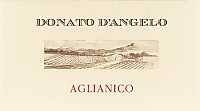
|
|
Aglianico del Vulture Donato D'Angelo 2001 |
|
| D'Angelo (Italy) | |
| Grapes: Aglianico | |
| Price: € 18.00 | Score: |
| This Aglianico shows a brilliant ruby red color and nuances of garnet red, little transparency. The nose reveals intense, clean, pleasing and refined aromas which start with hints of black cherry, blueberry and plum followed by aromas of blackberry, violet, vanilla, licorice, eucalyptus, cocoa and pink pepper. In the mouth has good correspondence to the nose, a tannic attack and however balanced by alcohol, full body, intense flavors, good tannins. The finish is persistent with flavors of black cherry, plum and blueberry. A well made wine. This Aglianico ages for 18 months in barrique followed by 8 months of aging in bottle. | |
| Food Match: Roasted meat, Game, Braised and stewed meat, Hard cheese | |
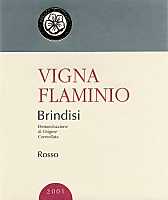
|
|
Brindisi Rosso Vigna Flaminio 2001 |
|
| Vallone (Italy) | |
| Grapes: Negroamaro (70%), Montepulciano (20%), Malvasia Nera (10%) | |
| Price: € 6.50 | Score: |
| The wine shows a brilliant ruby red color and nuances of ruby red, moderate transparency. The nose denotes intense, clean, pleasing and refined aromas which start with hints of black cherry, blueberry and plum followed by aromas of raspberry, cyclamen, licorice, blackberry, violet and vanilla. In the mouth has good correspondence to the nose, a slightly tannic attack and however balanced by alcohol, good body, intense flavors, good tannins, agreeable. The finish is persistent with flavors of black cherry, plum and blackberry. This wine ages for 8 months in cask. | |
| Food Match: Broiled meat, Stewed meat with mushrooms | |

|
|
Salice Salentino Rosso Vereto 2001 |
|
| Vallone (Italy) | |
| Grapes: Negroamaro (90%), Malvasia Nera (10%) | |
| Price: € 6.50 | Score: |
| This wine shows an intense ruby red color and nuances of garnet red, moderate transparency. The nose reveals intense, clean, pleasing and refined aromas which start with hints of black cherry, blackberry and carob followed by aromas of licorice, menthol, plum, dried violet, leather and vanilla. In the mouth has good correspondence to the nose, a slightly tannic attack and pleasing smoothness, however balanced by alcohol, good body, intense flavors, good tannins, agreeable. The finish is persistent with flavors of plum and black cherry. This Salice Salentino ages for 8 months in cask. | |
| Food Match: Roasted meat, Stewed meat with mushrooms, Hard cheese | |
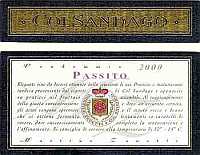
|
|
Passito 2000 |
|
| Col Sandago (Italy) | |
| Grapes: Prosecco | |
| Price: € 20.00 - 50cl | Score: |
| The wine shows a pale amber yellow color and nuances of golden yellow, transparent. The nose denotes intense, clean, pleasing and refined aromas which start with hints of citrus fruit peel and date followed by aromas of dried apricot, quince jam, dried fig, lavender, almond, honey and vanilla. In the mouth has good correspondence to the nose, a sweet attack and however balanced by alcohol, good body, intense flavors, agreeable. The finish is persistent with flavors of date, honey and quince jam. This wine is produced with dried Prosecco grapes and ages for about 20 months in cask. | |
| Food Match: Dried fruits desserts, Confectionery, Hard and piquant cheese | |
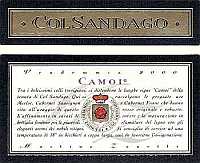
|
|
Camoi 2000 |
|
| Col Sandago (Italy) | |
| Grapes: Merlot (40%), Cabernet Sauvignon (40%), Cabernet Franc (20%) | |
| Price: € 18.00 | Score: |
| Camoi shows a brilliant ruby red color and nuances of garnet red, little transparency. The nose reveals intense, clean, pleasing and refined aromas which start with hints of black cherry, plum and black currant followed by aromas of vanilla, bell pepper, cocoa, eucalyptus, licorice and mace. In the mouth has good correspondence to the nose, a slightly tannic attack and however balanced by alcohol, good body, intense flavors, good tannins. The finish is persistent with flavors of black cherry, plum and black currant. A well made wine. Camoi ages for 16 months in cask followed by at least 6 months of aging in bottle. | |
| Food Match: Roasted meat, Braised and stewed meat, Hard cheese | |
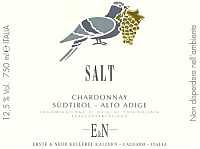
|
|
Alto Adige Chardonnay Salt 2003 |
|
| Erste & Neue (Italy) | |
| Grapes: Chardonnay | |
| Price: € 6.70 | Score: |
| The wine shows a brilliant golden yellow color and nuances of straw yellow, very transparent. The nose denotes intense, clean, pleasing and refined aromas which start with hints oh hawthorn, apple and pear followed by aromas of pineapple, broom, plum and hints of mineral. In the mouth has good correspondence to the nose, a crisp attack and however balanced, good body, intense flavors. The finish is persistent with flavors of pineapple, pear and apple. This Chardonnay ages in steel tanks. | |
| Food Match: Fish and crustaceans appetizers, Fried fish, Sauteed fish, Pasta and risotto with fish and crustaceans | |
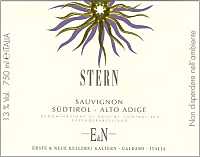
|
|
Alto Adige Sauvignon Stern 2003 |
|
| Erste & Neue (Italy) | |
| Grapes: Sauvignon Blanc | |
| Price: € 9.50 | Score: |
| The wine shows a brilliant straw yellow color and nuances of greenish yellow, very transparent. The nose reveals intense, clean, pleasing and refined aromas which start with hints of peach and pear followed by aromas of grape, elder, hawthorn, banana, broom, litchi and hints of mineral. In the mouth has good correspondence to the nose, a crisp attack and however balanced by alcohol, good body, intense flavors, agreeable. The finish is persistent with flavors of peach, pear and litchi. This Sauvignon Blanc ages in steel tanks. | |
| Food Match: Fish and crustaceans appetizers, Pasta and risotto with fish and vegetables | |
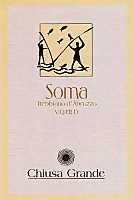
|
|
Trebbiano d'Abruzzo Soma 2003 |
|
| Chiusa Grande (Italy) | |
| Grapes: Trebbiano d'Abruzzo | |
| Price: € 5.00 | Score: |
| The wine shows a brilliant greenish yellow color and nuances of greenish yellow, very transparent. The nose reveals intense, clean and pleasing aromas which start with hints of hawthorn, pear and apple followed by aromas of lemon, broom and plum. In the mouth has good correspondence to the nose, a crisp attack and however balanced by alcohol, light body, intense flavors. The finish is persistent with flavors of apple and pear. | |
| Food Match: Aperitifs, Vegetables appetizers, Dairy products, Pasta and risotto with vegetables and crustaceans | |
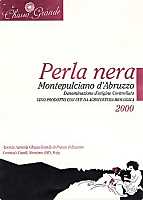
|
|
Montepulciano d'Abruzzo Perla Nera 2000 |
|
| Chiusa Grande (Italy) | |
| Grapes: Montepulciano | |
| Price: € 12.00 | Score: |
| The wine shows an intense ruby red color and nuances of ruby red, little transparency. The nose reveals intense, clean, pleasing, refined and elegant aromas which start with hints of plum, blackberry and black cherry followed by aromas of licorice, violet, tobacco, vanilla, white pepper, chocolate, eucalyptus and mace. In the mouth has good correspondence to the nose, a tannic attack and however well balanced by alcohol, full body, intense flavors, good tannins, agreeable. The finish is persistent with flavors of black cherry, plum and blueberry. A well made wine. This Montepulciano ages for 18 months in barrique. | |
| Food Match: Roasted meat, Game, Braised and stewed meat, Hard cheese | |
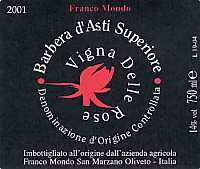
|
|
Barbera d'Asti Superiore Vigna delle Rose 2001 |
|
| Franco Mondo (Italy) | |
| Grapes: Barbera | |
| Price: € 10.00 | Score: |
| This wine shows an intense ruby red color and nuances of ruby red, little transparency. The nose denotes intense, clean, pleasing and refined aromas which start with hints of black cherry, blackberry and plum followed by aromas of blueberry, licorice, carob, dried violet and hints of vanilla. In the mouth has good correspondence to the nose, a slightly tannic attack and however balanced by alcohol, good body, intense flavors, good tannins. The finish is persistent with flavors of black cherry, plum and blueberry. This Barbera ages for some months in barrique. | |
| Food Match: Broiled meat and barbecue, Roasted meat, Hard cheese | |

|
|
Piemonte Moscato Passito Sileo 2001 |
|
| Franco Mondo (Italia) | |
| Grapes: Muscat Blanc | |
| Price: € 16.00 - 500ml | Score: |
| This wine shows a brilliant amber yellow color and nuances of amber yellow, transparent. The nose reveals intense, clean, pleasing, refined and elegant aromas which start with hints of raisin and fig jam followed by aromas of candied fruit, apricot jam, quince jam, peach jam, date, almond, lavender, citrus fruits peel, honey, Orange marmalade and vanilla. In the mouth has good correspondence to the nose, a sweet and smooth attack, however well balanced, good body, intense flavors, agreeable. The finish is persistent with flavors of raisin, peach jam, honey and fig jam. A well made wine. Sileo ferments in barrique. | |
| Food Match: Confectionery, Fruit tarts, Hard and piquant cheese | |
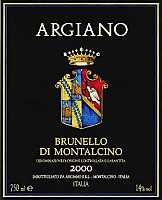
|
|
Brunello di Montalcino 2000 |
|
| Argiano (Italy) | |
| Grapes: Sangiovese Grosso | |
| Price: € 33.50 | Score: |
| This Brunello shows a brilliant ruby red color and nuances of garnet red, moderate transparency. The nose reveals intense, clean, pleasing and refined aromas which start with hints of black cherry, plum and dried violet followed by aromas of blueberry jam, raspberry jam, vanilla, tobacco, licorice, menthol and cocoa. In the mouth has good correspondence to the nose, a slightly tannic attack and pleasing crispness, however balanced by alcohol, full body, intense flavors, good tannins. The finish is persistent with flavors of black cherry, plum and blueberry jam. This Brunello di Montalcino ages for 12 months in barrique followed by 12 months of aging in cask. | |
| Food Match: Game, Braised and stewed meat, Roasted meat, Hard cheese | |
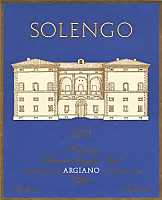
|
|
Solengo 2002 |
|
| Argiano (Italia) | |
| Grapes: Cabernet Sauvignon, Merlot, Syrah | |
| Price: € 62.50 | Score: |
| Solengo shows an intense ruby red color and nuances of garnet red, little transparency. The nose reveals intense, clean, pleasing, refined and elegant aromas which start with hints of black cherry, black currant and plum followed by aromas of blackberry, blueberry jam, toasted wood, vanilla, tobacco, licorice, eucalyptus, chocolate and black pepper. In the mouth has good correspondence to the nose, a tannic attack and however balanced by alcohol, full body, intense flavors, good tannins, agreeable. The finish is very persistent with flavors of black currant, black cherry, plum and blackberry. A well made wine. Solengo ages for 14 months in barrique. | |
| Food Match: Game, Braised and stewed meat, Roasted meat, Hard cheese | |
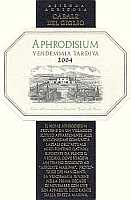
|
|
Aphrodisium 2004 |
|
| Casale del Giglio (Italy) | |
| Grapes: Viognier, Fiano, Greco Bianco, Petit Manseng | |
| Price: € 21.50 - 500ml | Score: |
| The wine shows a pale golden yellow color and nuances of straw yellow, very transparent. The nose reveals good personality with intense, clean, pleasing, refined and elegant aromas which start with hints of grape, candied fruit, citrus fruits peel followed by aromas of apricot, banana, date, litchi, vanilla, honey, pear and almond. In the mouth has good correspondence to the nose, a sweet and smooth attack with pleasing crispness, however balanced by alcohol, good body, intense flavors, agreeable. The finish is persistent with flavors of grape, pear and banana. A well made wine. Aphrodisium ferments in barrique. | |
| Food Match: Fruit tarts, Hard cheese | |

|
|
Colli Orientali del Friuli Rosazzo Bianco Ronco delle Acacie 2001 |
|
| Le Vigne di Zamò (Italy) | |
| Grapes: Chardonnay, Tocai Friulano, Pinot Blanc | |
| Price: € 17.00 | Score: |
| The wine shows an intense straw yellow color and nuances of golden yellow, very transparent. The nose reveals intense, clean, pleasing and refined aromas which start with hints of apple, hawthorn and ripe peach followed by aromas of pineapple, banana, almond, hazelnut, honey, plum and vanilla. In the mouth has good correspondence to the nose, a crisp attack and pleasing smoothness, however balanced by alcohol, good body, intense flavors, agreeable. The finish is persistent with flavors of plum, almond and apple. A well made wine. Ronco delle Acacie ages in cask for 9-10 months followed by 14 months of aging in bottle. | |
| Food Match: Fish and mushrooms soups, Stuffed pasta, Roasted fish, Roasted white meat | |

|
|
Colli Orientali del Friuli Rosso Ronco dei Roseti 2000 |
|
| Le Vigne di Zamò (Italy) | |
| Grapes: Merlot, Cabernet Franc, Cabernet Sauvignon, Schioppettino | |
| Price: € 24.00 | Score: |
| This wine shows a brilliant ruby red color and nuances of garnet red, little transparency. The nose denotes intense, clean, pleasing and refined aromas which start with hints of black currant, black cherry and plum followed by aromas of blueberry, vanilla, tobacco, licorice, eucalyptus, cocoa, cinnamon, pink pepper and hints of bell pepper. In the mouth has good correspondence to the nose, a slightly tannic attack and however balanced by alcohol, full body, intense flavors, good tannins, agreeable. The finish is persistent with flavors of black cherry, black currant and plum. A well made wine. Ronco dei Roseti ages in barrique for 15-18 months followed by 5 months of aging in cask. | |
| Food Match: Roasted meat, Game, Braised and stewed meat, Hard cheese | |
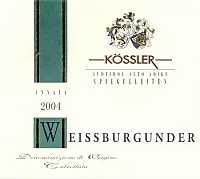
|
|
Alto Adige Terlano Pinot Bianco Spiegelleiten 2004 |
|
| Kössler (Italy) | |
| Grapes: Pinot Blanc | |
| Price: € 5.95 | Score: |
| This wine shows a brilliant greenish yellow color and nuances of greenish yellow, very transparent. The nose reveals intense, clean and pleasing aromas which start with hints of hawthorn, apple and pear followed by aromas of citrus fruits, pear, plum and hints of hop. In the mouth has good correspondence to the nose, a crisp attack and however balanced by alcohol, light body, intense flavors. The finish is persistent with flavors of pear, apple and pineapple. This Pinot Blanc ages in steel tanks. | |
| Food Match: Dairy products, Vegetables appetizers, Pasta and risotto with vegetables | |

|
|
Alto Adige Pinot Noir 2000 |
|
| Kössler (Italy) | |
| Grapes: Pinot Noir | |
| Price: € 9.80 | Score: |
| This wine shows a brilliant ruby red color and nuances of garnet red, moderate transparency. The nose denotes intense, clean, pleasing and refined aromas which start with hints of cherry, raspberry and plum followed by aromas of blueberry, strawberry jam, licorice, violet and vanilla. In the mouth has good correspondence to the nose, a slightly tannic attack and pleasing crispness, however balanced by alcohol, good body, intense flavors, good tannins. The finish is persistent with flavors of cherry, raspberry and plum. This Pinot Noir ages for 12 months in barrique. | |
| Food Match: Roasted meat, Stewed meat with mushrooms, Broiled meat and barbecue | |
Livio FellugaEverything begins, or better to say, begins again, after the world war two, when in the 1950's Livio Felluga, patriarch of Friuli's enology, decided to turn his dream into reality |
|
Friuli Venezia Giulia certainly is among the most representative regions of Italy according to a wine making point of view, and in particular, this region has always been appreciated for white wines, a practically implicit association which has consolidated with time. It is right among white wines which are found interesting expressions of autochthonous grapes famous worldwide and which represent two different wine styles identifying the enology of the region. Tocai Friulano, indisputable protagonist of the great white wines from Friuli Venezia Giulia, and the precious Picolit, with which are being produced excellent sweet wines, not only of this region, but also of Italy. Even red berried grapes are abundant in this region and among them, the one which is particularly distinguished, is Refosco dal Peduncolo Rosso, protagonist of interesting wines.
In this region is also found one of the most interesting and famous wineries of Italy - Livio Felluga winery - which has now become a solid reference point thanks to the constant quality of its wines, a certainty which distinguishes the enology of Friuli and of Italy as well. Despite Livio Felluga winery was established in 1956, the enological tradition of the Felluga family has a more ancient history of five generations long. In a period in which the geographical borders of this region are continuously confounded with the ones of Slovenia, and while waiting for the war facts of the 1900's to devastate the destiny of this land and of its people, Felluga family lived in the Istrian peninsula where it owned vineyards planted with Malvasia and Refosco and with which produced its wines. It was only in 1920 that Livio Felluga's grandfather decided to expand his wine business and gave his son Giovanni the responsibility of the commercial aspects in the city of Grado. It was in that period that the “kid” Livio Felluga began to get into enology among the bottles and wines produced by the family business. At the end of 1930's Felluga family decided to move to Friuli Venezia Giulia in the Collio area. Since those times Livio Felluga had very clear in his mind his project of enological production and was convinced wine was - first of all - the result of a strict quality which originated from the vineyards and completed in the cellar. Livio Felluga's projects were interrupted - as well as the ones of others - with world war two - in June 1940 - when he was called to the arms. Despite the events and the hard experiences the tragedy of every war leaves in the soul of men who are called to combat it, Livio Felluga returns to his Collio lands and decided to resume his project and to turn his dreams into reality.
Livio Felluga's dream is realized when in 1950's he finally bought a vineyards of few hectares in the Rosazzo area. During those years Italy was still a victim of the consequences of war and the people only wanted to throw everything away and to change their lives. These are the years in which the countryside is abandoned by their people attracted by the city life and a job in the industries. In this scenario of cultural and traditional decay for the Italian agricultural world, Livio Felluga tenaciously decides to continue the job for his dreams and with the goal of giving a new life to those hills. At those times there were few people who believed in the resources of agriculture and only time let us know Livio Felluga was right - as well as all the other ones who believed in similar dreams - and today he is considered by all as the patriarch of the enology's renaissance in Friuli Venezia Giulia. Livio Felluga also had the merit for “discovering” the extraordinary viticultural vocation of Rosazzo, a quality which is well represented by two of the great wines produced by this winery: Colli Orientali del Friuli Rosazzo Bianco Terre Alte and Colli Orientali del Friuli Rosazzo Rosso Riserva Sossò. Livio Felluga's winery is today located at Brazzano and owns more than 160 hectares of land (about 400 acres) of which 135 (about 330 acres) destined to vineyards and from which are being produced 650,000 bottles. Livio Felluga's wines are now famous in every country of the world, a sign of the enological excellence of Friuli Venezia Giulia and of Italy. The main reference markets are Italy, the European continent, United States of America, Japan, Australia and South America. Today the winery is run by Livio Felluga's sons: Maurizio, Elda, Andrea and Filippo. The excellence of the wines produced by this prestigious winery certainly is confirmed by tasting: all the wines are convincing and with no exception, both whites and reds. Among all wines, the excellent qualities of the white Terre Alte and the red Sossò are truly convincing. A particular mentions goes to the elegant white wine Rosenplatz, very well made and truly agreeable.
|
||||||||||||||||
|
Score legend Prices are to be considered as indicative. Prices may vary according to the country or the shop where wines are bought |
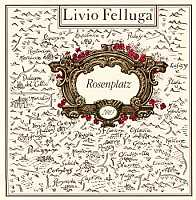
|
|
Collio Bianco Rosenplatz 2003 |
|
| Livio Felluga (Italy) | |
| Grapes: Chardonnay (65%), Sauvignon Blanc (35%) | |
| Price: € 12.50 | Score: |
| This wine shows a brilliant straw yellow color and nuances of straw yellow, very transparent. The nose reveals intense, clean, pleasing and refined aromas which start with hints of hawthorn, apple and peach followed by aromas of acacia, banana, broom, yellow rose, plum, grape, litchi and pear. In the mouth has good correspondence to the nose, a crisp attack and pleasing smoothness, however balanced by alcohol, intense flavors, agreeable. The finish is persistent with flavors of peach, pear and plum. A well made wine. Rosenplatz ages for some months in barrique followed by 5 months of aging in bottle. | |
| Food Match: Stuffed pasta, Fish and mushrooms soups, Sauteed fish | |
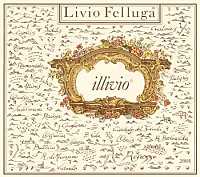
|
|
Colli Orientali del Friuli Bianco Illivio 2001 |
|
| Livio Felluga (Italy) | |
| Grapes: Pinot Blanc | |
| Price: € 20.30 | Score: |
| The wine shows a brilliant golden yellow color and nuances of straw yellow, very transparent. The nose reveals intense, clean, pleasing and refined aromas which start with hints of toasted wood, banana and plum followed by aromas of hawthorn, honey, mineral, banana, apple, ripe peach and grapefruit. In the mouth has good correspondence to the nose, a crisp attack and pleasing smoothness, however balanced by alcohol, good body, intense flavors. The finish is persistent with flavors of apple, plum and banana. Illivio ages in barrique for about 10 months followed by at least 16 months of aging in bottle. | |
| Food Match: Roasted fish, Roasted white meat, Stewed fish | |

|
|
Vertigo 2002 |
|
| Livio Felluga (Italy) | |
| Grapes: Merlot (60%), Cabernet Sauvignon (40%) | |
| Price: € 11.00 | Score: |
| The wine shows an intense ruby red color and nuances of ruby red, moderate transparency. The nose reveals intense, clean, pleasing and refined aromas which start with hints of plum and black cherry followed by aromas of violet, vanilla, blackberry, raspberry, cyclamen, blueberry and hints of bell pepper. In the mouth has good correspondence to the nose, a slightly tannic attack and however balanced by alcohol, good body, intense flavors, good tannins. The finish is persistent with flavors of black cherry and plum. Vertigo ages for 12 months in barrique followed by 4 months of aging in bottle. | |
| Food Match: Roasted meat, Stewed meat with mushrooms, Hard cheese | |

|
|
Colli Orientali del Friuli Rosazzo Rosso Riserva Sossò 2000 |
|
| Livio Felluga (Italy) | |
| Grapes: Merlot, Refosco dal Peduncolo Rosso | |
| Price: € 28.50 | Score: |
| The wine shows an intense ruby red color and nuances of ruby red, little transparency. The nose reveals intense, clean, pleasing and refined aromas which start with hints of black cherry and plum followed by aromas of black currant, blueberry, vanilla, violet, bell pepper, blackberry, cocoa, licorice and hints of eucalyptus. In the mouth has good correspondence to the nose, a tannic attack and however balanced by alcohol, full body, intense flavors, good tannins. The finish is persistent with flavors of plum, black currant and blueberry. A well made wine. Sossò ages for about 18 months in barrique followed by at least 12 months of aging in bottle. | |
| Food Match: Game, Roasted meat, Braised and stewed meat, Hard cheese | |
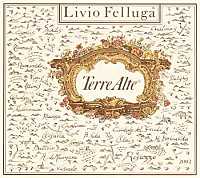
|
|
Colli Orientali del Friuli Rosazzo Bianco Terre Alte 2002 |
|
| Livio Felluga (Italy) | |
| Grapes: Sauvignon Blanc (40%), Tocai Friulano (30%), Pinot Blanc (30%) | |
| Price: € 25.00 | Score: |
| This wine shows an intense straw yellow color and nuances of straw yellow, very transparent. The nose reveals intense, clean, pleasing, refined and elegant aromas which start with hints of apple, pear and banana followed by aromas of hawthorn, litchi, butter, pineapple, almond, honey, mineral, peach, elder, grapefruit and plum. In the mouth has very good correspondence to the nose, a crisp attack and however balanced by alcohol, good body, intense flavors, agreeable. The finish is very persistent with long flavors of peach, plum, pear and litchi. A well made wine. The Tocai Friulano grape used for the production of this wine ferments and ages in barrique for about 10 months. Terre Alte ages in bottle for at least 12 months. | |
| Food Match: Roasted fish, Stuffed pasta, Stewed fish, Fish and mushrooms soups, Roasted white meat | |
| Livio Felluga - Via Risorgimento, 1 - 34071 Brazzano di Cormòns, Gorizia (Italy) - Tel. +39 481 60203 Fax. +39 481 630126 - Winemaker: Stefano Chioccioli - Established: 1956 - Production: 650.000 bottles - E-Mail: info@liviofelluga.it - WEB: www.liviofelluga.it |
Cellar Journal |
|
This section is reserved to wine producers who want to publish news and information about their business, to announce new products or just for communicating to its customers information and promotions about their products and activity. Send news to be published at our e-mail address.
|
Aquavitae: the New DiWineTaste's Distillates GuideThe Aquavitae column becomes today a new guide, a new tool offered to our readers for knowing and appreciating distillates |
In June 2004 we released a new column - Aquavitae - with the purpose of offering our contribution to the right culture of consumption and appreciation of these beverages. Today - after about one year - this column has changed and becomes a new tool offered to our readers, therefore representing the natural evolution that we thought about Aquavitae. From this month on the services offered by DiWineTaste to our readers are enriched by a new interactive guide, exclusively dedicated to all the distillates evaluated by our committee, and which supports our famous and widely used Wines Guide. The Aquavitae column will continue to be published in DiWineTaste although having a new purpose, that is to inform our readers about the monthly updates of this new guide. DiWineTaste's site is enriched by a new function which is freely accessible to our readers and visitors. The new distillates guide Aquavitae is accessible at the page http://www.DiWineTaste.com/english/Aquavitae.php. The look and feel of Aquavitae are exactly the same used for the Wines Guide, therefore its usage will be easy for our readers who are already familiar with our services. Aquavitae is also integrated to our Services Directory, therefore it will be possible to know the shops where the distillates can be bought at. We invite all distillate producers who wish to have their products inserted in our new guide Aquavitae, to contact us at our e-mail address or to fill in the form available at our site.
|
||||||||
News |
|
In this section will be published news and information about events concerning the world of wine and food. Whoever is interested in publishing this kind of information can send us a mail at our address.
|
DistillationA noble art with a long and rich history, the result of a wise process capable of extracting the soul of a product and to transform it into precious and elegant aromas |
|
The world of distillates - such as grappa, fruit brandies, brandies, cognac, armagnac and calvados - represents an universe rich in history, traditions and man's talent who in the course of centuries has been successful in improving an ancient technique in order to extract the most intimate part of the matter for the production of essences. The history of distillation is an amazing course made of intuitions, mistakes and progresses, until our days where the talent of wise distillation masters are capable to obtain products and beverages of very high quality and finesse. Distillation is not only the result of the skill of talented men, it is also the result which is obtained by the characteristics of an alembic still and by the way it is being used and - last but not the least - the quality and nature of the raw matter to be distilled.
|
|
The origins of distillation are dated back to very ancient times and it is not clear how it was discovered. It is more likely the invention of distillation is to be recognized to ancient Egyptians and Persians, who subsequently passed this knowledge to Arabs. Despite today it is not clear what were the matters used at those times for the distillation, it is however certain distillation was used for alchemical purposes and for the production of medical and therapeutic remedies. Written evidences about alchemy and medicine which have survived up to nowadays, thoroughly describe the distillation of officinal herbs, the methods used to extract essences and their usage for therapeutic purposes. It is certain Egyptians knew the distillation technique since 4000 B.C. and Cleopatra, the Egyptian scientist and homonymous of the famous queen, described in his writings the alembics used at those times and, in particular, a type of alembic with an air operated steam cooler, later known as Cleopatra's Crisopaea.
The spreading of distillation and of alembic was probably done by Arabs. Some believes grappa - the renowned Italian distillates obtained by grape pomace - was produced for the first time in Sicily when Arabs introduced the alembic and from here it spread all over the Italian territory. Even today the influence of Arab culture on the art of distillation is present in the name of two terms strictly associated to this practice: alembic e alcohol. The word alembic derives from the Arab Al-Anbiq, whereas alcohol derives from the Arab Al-Kulh. With this term it is referred the fine cosmetic powder used to draw the border of eyelids and - for extension - every type of impalpable powder representing the concentration of a matter, or in case of alcohol, the quintessence or spirit of a fermented matter from which it is being produced. With Romans the alembic was improved and it is right in this period the quantity of raw matters from which extracting alcohol and essences increased: not only officinal herbs but also wine, fruit ciders and fermented grains. As the distillate substances increased, this practice was not exclusively used for the production of therapeutic remedies and this led to the production of distillates used as beverages. With the arrive of the eleventh century we find the first written documents about the distillation of wine and about the concentration of alcohol: these rules were set by the famous Salernitan School. In fact, it can be said the development of the distillation of wine and of grape pomace has greatly improved thanks to the contribution of Italy. The invention of new and sophisticated alembic stills will later allow alchemists to make the famous aqua ardens (burning water) - as that crystalline liquid, similar to water, was easily flammable - and aqua vitae, that is water of life. The practice of distillation rapidly spread all over Italy and Europe. In the 1400's and 1500's, as witnessed by many documents of those times, the distillation of grape pomace and the production of grappa were widely practiced in Friuli Venezia Giulia and in Veneto, and since those times the renowned Italian distillate was exported in many European countries. In the course of the Middle Age wine distillates become very common, in particular in Germany, where they were known as gebrandtwein (burnt wine), a term derived from the Dutch brandewijn which will later become brandy. In later years the technique of distillation pays its attention on the development of devices capable of increasing the concentration of alcohol and around the half of 1600's Giambattista Porta invented the hydra with seven heads. This system never had any practical application, however thanks to this idea, in the 1700's Boerhaave developed the first distillation column which allowed a higher concentration of alcohol. The construction of alembic stills will be highly developed in Italy and in particular for the production of grappa. The most common system used to heat the raw matter to be distilled was represented by a heat source in direct contact to the boiler containing the raw matter. This system did not allow an efficient control over the temperature with the risk of burning the pomace. New alembics were then invented in which the boiler containing the grape pomace to be distilled was not in direct contact with fire, leading to the introduction of the classic water bath alembics and steam operated boilers. This type of alembics allowed the distillation of raw matters with pretty long times and at the end of every operation it was necessary to unload the exhausted matter and to restart the procedure from the beginning. In order to limit this inconvenience were introduced continuous machines - also known as disalcoholators - which allowed the distillation of grape pomace and of wine without any interruption, therefore reducing the distillation times while increasing the quantity of the processed matter.
|
||||||||
|
The distillation technique is based on the principle of boiling a liquid and to the subsequent cooling and concentrations of its vapors. In the specific case of brandies, the distillation process essentially consists in separating and concentrating alcohol. Despite the principle on which is based the distillation is unique, this process can be achieved with different methods, each of them having proper characteristics which will affect the organoleptic qualities of the finished product. The distillation is obtained by using alembic stills whose constructive characteristics determine the method. In the course of centuries the distillation process has developed thanks to the progresses done in the construction of alembics and, in particular, in the technical solutions adopted for the concentration of alcohol and for the keeping of the distillating matter's qualities. An alembic still, despite the way it is being constructed, is made of fundamental parts which allow the raw matter to be distilled to boil and which is subsequently cooled down in order to concentrate its vapors. Before discussing the main types of alembics used for the distillation of alcoholic beverages, it is appropriate to list their components and their functions. The heat source is responsible for heating the matter until boiling; the boiler (also known as cucurbit) contains the raw matter to be distilled; the cover (also known as dome, capital or helmet) which closes the boiler and begins the concentration and the cooling down of vapors; the collector (also known as swan neck) which transports the vapors from the boiler to the cooler; the cooler which condensates the vapors and takes them back to their liquid state and from its end is obtained the distillate. Alembics are divided into two categories: continuous and discontinuous. Continuous alembics - also known as disalcoholators - allow a distillation with no interruptions, whereas in discontinuous alembics it is necessary to divide the working procedures - each of them defined as chauffe - in which the alembic's boiler is filled with the raw matter to be distilled, then follows the distillation and finally, after having unloaded the exhausted part, the cycle is repeated. In the continuous alembic the raw matter is continuously loaded in the device and processed by a steam flow which extracts the volatile components. The alcoholic vapors will raise to the column, which thanks to its characteristics will concentrate alcohol, and then passes through the cooler which transforms it into a liquid. Continuous devices allow the processing of huge quantities of raw matter in a short time and give a distillate with no faults. Despite the technological improvements introduced in these devices, the result will not have the same personality of a distillate obtained with a discontinuous alembic as the possibilities for the master distiller to control the process are limited. Discontinuous alembics are the ones generally used by small distilleries where the processing is done with craftsmanship criteria and the skill of the master distiller can be completely expressed. The fundamental characteristic of a discontinuous alembic is represented by the heat source and the way the heat is transmitted to the matter to be distilled. Discontinuous alembics are divided into direct heat, water bath and steam operated boilers. In direct heat alembics the boiler is in direct contact with the fire, therefore their usage is more difficult because of the lesser control over the temperature that can also burn the raw matter. In water bath alembics, the boiler has a hollow space in which hot water or steam is being flowed. In this way it is possible a gradual and constant heating of the raw matter while avoiding any possible burning. Alembics with steam operated boilers - currently the most common type in Italy for the production of grappa - allow the extraction of volatile components by having the raw matter passed by a steam flow. The boilers of these alembics have some baskets in which is put the grape pomace that will be then passed by the steam. Despite the way in which the matter is being heated, vapors go up to the alembic's dome in which takes place the first alcoholic concentration, it is then transported to the cooler which will give the distillate in its liquid form.
|
||||
|
The distillation has the purpose of separating alcohol from a raw matter - fermented grape pomace, wine or other fermented matters - and it is always based on the same principle. Ethyl alcohol begins to boil - and therefore to evaporate - at a temperature of 78.4°C (173°F) and water at 100°C (212°F). These two factors are of primary importance as the matter to be distilled is not exclusively made of alcohol, but also water and other substances. The evaporation of raw matter's components will occur at a temperature from 78.4°C and 100°C, according to the quantity of alcohol found in the matter. The higher the quantity of alcohol found in the raw matter - and therefore the lesser the quantity of water - the lower the temperature will be towards the one of alcohol. The skill of the master distiller also consists in keeping the alembic at the right temperature in order to have the alcohol and the aromatic substances evaporate while extracting the least possible quantity of water. The process of distillation begins by filling the boiler with the raw matter which will be subsequently heated. The distillation process allows the evaporation of many substances, including the ones having negative organoleptic qualities and that will be eliminated in order not to compromise the qualities of the distillate. This operation is called cut of heads and tails. These unwanted substances have boiling temperatures different from ethyl alcohol and other positive substances, therefore their elimination is done by means of an accurate control of the temperature. the first part of the distillate produced by this process is called head and it is made of unpleasing and noxious substances - such as methyl alcohol - and therefore it is eliminated. The second part of the distillate is called heart and it is made of all those substances whose boiling occurs between 78.4°C and 100°C, all of them being considered positive and fundamental for the organoleptic qualities of the distillate. The final part of the distillate - called tail - is made of substances which boil at a temperature higher than 100°C and which give the distillate unpleasing aromas and tastes, therefore they must be eliminated. It should be remembered many of these substances are however transported by the vapors of the heart, therefore it will be the skill of the master distiller to ensure the distillate will be exclusively made of good substances. The skill of the master distiller - and his skill to cut heads and tails - will give the distillate its personality. At the end of the processing the distillate will be properly stabilized - as well as being aged in containers according to the type of beverage to be produced - and then reduced to its typical alcohol volume.
|
SaltSalty is one of the fundamental tastes. Animals walk long distances in order to taste salt, whereas for humans, since ancient times, it has been a resource for profitable trades |
|
In the Italian culture it is said “having the salt in one's head” or “the salt of life”. Two sayings which let us understand the importance of salt in human culture and society. The fundamental tastes traditionally recognized are four - sweet, salty, sour and bitter - and in recent times it was also added a fifth one, called “umami”. The tongue has a series of gustatory receptors - also known as taste buds - specialized in perceiving fundamental tastes and the ones located at the sides of the tongue seem to be particularly sensitive to salty taste, and - as soon as it is being perceived - it originates a sensation of sapidity while exalting the taste of foods. Most of chlorides are noxious or laxative and they frequently have a slightly bitter taste. Sodium chloride - which chemical formula is NaCl - is responsible of salty taste, it is one of the fundamental minerals for animal's life and it is available in nature in huge quantities dissolved in sea water. The ones who are lucky to travel to Himalaya - in particular in Tibet - can see goats carrying bags of salts on their backs. Even in Africa can be seen caravans of dromedaries which from the northern part of Ténéré desert go to Sahel and transport salt, then go back to their original places loaded with goods and foods, exchanged in the crowded and colored African markets. History taught us the importance of salt was so high it was used as a money for the trading of goods. Not only humans are attracted by salt: animals walk long distances in order to go to those places in which it is possible to lick salt.
The daily intake of salt in an adult subject is usually of 9 grams, of which only about one gram is naturally found in foods, whereas the rest is added during the preparation of recipes. Sodium plays an important role in human body and in normal conditions the consumption of salt should not exceed six grams a day, corresponding to 2-4 grams of sodium. An excessive consumption of salt, and therefore of sodium, in some subjects can be cause of hypertension. It should be remembered salt is naturally present in all foods, although in modest quantities, of course. Besides the salt added in the cooking of foods, it should also be considered the one used by the food industry as a preservative and for the exaltation of tastes. Sodium is mainly obtained by sodium chloride, the common kitchen salt. In our body there is a system regulating the sodium intake and which is governed by a hormone, the aldosterone. In case the quantity of sodium is too low, aldosterone stimulates the kidneys in order to favor the absorption from the urine. In case the quantity of sodium is excessive, the aldosterone is deactivated and the sodium is expelled by means of urine. Thanks to this system, the excess of sodium does not cause any problem in healthy subjects. In subjects in which the system regulated by the aldosterone does not work properly, the consumption of sodium can be cause of hypertension problems. For this reason subjects suffering from hypertension should limit the consumption of kitchen salt and do not exceed 3 grams of daily intake. On this regard it is appropriate to remember some foods contain high quantities of sodium or are however naturally rich in sodium. In this category are found cheese, canned fish, pickled foods, cold cuts, eggs, sea foods, some vegetables such as carrots, onions, spinach, artichokes and beets. Sodium should not be completely eliminated from the diet, it should be adequately reduced and in a pretty gradual way. Sodium helps the regulation of corporal water balance, stimulates muscular contraction and the nervous system, regulates the corporal acid balance and plays an important role in regulating blood pressure. Salt is a highly hygroscopic substance, a characteristic which can be easily observed by spreading salt on the slices of a fresh eggplant: after some hours the eggplant will have lost lots of water. Adding the right quantity of salt to a dish is so important that Arnaud Cazenade believes that «French cooks are satisfied only in case the foods leave the kitchen, with their final approval, and nothing else must be added, not even salt or pepper». A bit excessive statement as every individual has his or her personal sensitivity to salt, however it can be said that, in general terms, when someone adds salt to foods for more than two or three times, this means the cook did not do a good job. Whenever it is possible, the last adding of salt should be done at the end of cooking, when the sauce has been reduced. In case this simple rule is not followed, it will be more likely the sauce to be too salty. As for broiled meat or barbecue, it is advised to add salt almost at the end of cooking. Adding salt to meat in the beginning means causing the leakage of blood and other liquids, while hardening the meat. Adding salt at the end of cooking, does not allow the complete development of taste. In case it is not possible to add salt at the end of cooking, it is a good habit to weigh salt. When the mistake of adding too salt to a food has made, the remedies that can be used are very few. Sugar is known to contrast salt, however it is not a good idea to add huge quantities of sugar. It does contrast salt, it does not eliminate it. The only efficient remedy is to increase the quantity of the other ingredients in order to dilute the excessive salt. Salt is also added to the water used to boil vegetables. It is not a matter of taste only: the salt contained in the water used for boiling vegetables avoids the excessive extraction of mineral salts while increasing the boiling temperature of water. Salt - and this is known since ancient times - is an excellent preservative. Thanks to the osmotic effect, salt tends to absorb water and this is the reason why salt is added to vegetables before keeping them in vinegar. The preservative effects of salt are not only because of its capacity of absorbing water. The presence of salt completely prevents or inhibits the development of some organisms: for this reason it is being used for keeping meat, fish and vegetables. Salt is not used in kitchen only. In past times - and probably in recent times as well - people working in salt-works who stayed for months with their legs in saltish water and in the mud, rarely suffered from rheumatic diseases. The black mud deposited in the bottom of salt-works was used as a remedy for arthritis and distortions: it was spread on the part and left to dry. The salt of the Dead Sea, very rich in minerals such as magnesium, sodium potassium, calcium and sulphur, is a natural resource used as a remedy in order to give compactness and elasticity to tissues, as antirheumatic, against muscular pain and as a skin purifier. Famous are the muds of the Dead Sea very rich in salt and minerals and that were used since Roman times both directly or added to creams, soaps and cosmetics. In case it is being asked a general opinion about wine, the most probably answer could be “which wine?”, as all wines are different one from each other. The same is true for salt as well. The salt usually found in market is never pure and, because of its origin, together with sodium chloride are also found other substances which make every salt different from another, both for its salty properties and for the aromas. Moreover there are appreciable differences among salts from different countries. Rock-salt is found in underground deposits originated by the drying up of seas, it has a crystalline appearance, it is white colored as well as pink colored because of the presence of iron salts. Besides iron salts, in some natural salt deposits it is possible to find traces of soda and noxious salts, such as arsenic salts. For this reason the salt used for nutritional purposes is from safe deposits only.
|
||||||||||||
|
Kitchen salt is obtained from the deposits of rock-salt, the technique of extraction consists in pumping water in the underground layers rich in salt, then the water, which has now diluted the salt, is pumped back. This water is then poured in containers and allowed to evaporate in order to leave salt crystals only. The product obtained this way is usually found in many countries in the form of blocks or tablets. Table salt is obtained with the same procedure, however it is properly treated in order to avoid the hardening and finely ground. The level of purity of this salt is pretty high, it is depurated from other hygroscopic salts and usually added with starch, calcium phosphate and other substances. This type of salt is very poor in aromas. Sea salt - so called because it is obtained by evaporating sea water - is very common in many countries, in other can be found in specialized shops only. Sea salt is obtained by allowing sea water to evaporate in large containers usually located in the coasts, the so called salt works. In general terms, the procedure of extraction of sea salt is unique, however every country has its own techniques - more or less efficient - from artisan and traditional ones, to industrial ones. Sea water, during the periods of high tides, enters large vats where it is left to stay and in order to allow scoriae to deposit. The second phase consists in transferring the water from the first vat to the second one where it is allowed to evaporate therefore reducing its volume. In the next phase the water of the second vat is transferred in the third vat and here it will completely evaporate while leaving the salt on the bottom. In traditional salt-works, salt is collected by hand, dried and cleaned in a natural way. In “industrial” salt-works, salt is being collected by using machineries and then refined and purified, an operation which can also make use of other mineral salts. Sea water contains high quantities of sodium chloride and other elements, such as iodine (useful for the good health of thyroid), magnesium, potassium, zinc, iron and sulphur, substances which make salt particularly rich and tasty. Moreover can be found salts with a bad taste and even with noxious substances, however their content is so low and can be considered negligible. Refined salt undergoes a cleaning process which eliminates a good part of mineral salts, including iodine, which can be subsequently added in order to obtain “iodine salt” usually sold in shops. Whole sea salt has a good aroma and it is more tasty than others, however it is always advisable not to exceed with its consumption. Some believes refined salt lacks of the essential mineral salts useful for the body, therefore believe it is better to make use of whole sea salt, where these minerals are found in higher quantities. Spicy salts are home made products which are now available in shops too. They are made by adding spices and aromatic herbs to the salt in order to give it more aromas. In the market are also available aromatic salts which can be easily made at home. For example it is enough to put in a container salt and garlic, salt and celery, or any other combination suggested by fantasy. Moreover there also are salts of vegetal origin - naturally found in vegetables - which are indispensable for the good health of human body.
|
AquavitaeReview of Grappa, Distillates and Brandy |
|
|
| Distillates are rated according to DiWineTaste's evaluation method. Please see score legend in the "Wines of the Month" section. |

|
|
Grappa di Inzolia 2003 |
|
| Giovi (Italy) | |
| Raw matter: Pomace of Inzolia | |
| Price: € 14.55 - 50cl | Score: |
| The grappa is colorless, limpid and crystalline. The nose reveals delicate, clean and pleasing aromas of hawthorn, hazelnut, pear and banana, imperceptible alcohol pungency. In the mouth is intense with evident alcohol pungency which tends to dissolve rapidly, dry taste and balanced sweet hint. The finish is persistent with flavors of hazelnut and pear. This grappa is produced with a water bath discontinuous alembic still. Alcohol 42%. | |

|
|
Acquavite di Melograno |
|
| Giovi (Italy) | |
| Raw matter: Pomegranate | |
| Price: € 28,85 - 20cl | Score: |
| This distillate is colorless, limpid and crystalline. The nose reveals delicate, clean, pleasing and refined aromas of pomegranate, chamomile, raspberry, apple and broom with almost imperceptible alcohol pungency. In the mouth is intense and agreeable with alcohol pungency which tends to dissolve rapidly, good and balanced sweet hint, agreeable. The finish is very persistent with flavors of pomegranate, raspberry and apple. A well made distillate. This distillate is produced with a water bath discontinuous alembic still. Alcohol 43%. | |

|
|
Distillato d'Uva Rossa Spiritus |
|
| Scubla (Italy) | |
| (Distiller: Distillerie De Mezzo) | |
| Raw matter: Fragolino grape - Isabella variety | |
| Price: € 19.00 - 50cl | Score: |
| This distillate is colorless, limpid and crystalline. The nose denotes good personality with intense, clean and pleasing aromas of strawberry, beeswax, jasmine, raspberry and cherry with almost imperceptible alcohol pungency. In the mouth is intense with alcohol pungency that tends to dissolve rapidly, pleasing sweet hint and pretty dry taste. The finish is persistent with flavors of strawberry and beeswax. This distillate is produced with a water bath alembic still. Alcohol 43%. | |

|
|
Distillato d'Uva Verduzzo Appassita Spiritus |
|
| Scubla (Italy) | |
| (Distiller: Distillerie De Mezzo) | |
| Raw matter: Dried Verduzzo Friulano Grape | |
| Price: € 22.50 - 50cl | Score: |
| This distillate is colorless, limpid and crystalline. The nose reveals intense, clean and pleasing aromas of raisin, honey, hazelnut, pear, apple, broom and banana with almost imperceptible alcohol pungency. In the mouth is intense with evident alcohol pungency which tends to dissolve rapidly., good and balanced sweet hint and pleasing roundness. The finish is persistent with flavors of raisin, apple and hazelnut. This distillate is produced with a water bath alembic still. Alcohol 43%. | |
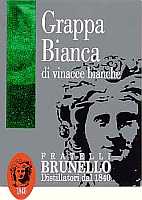
|
|
Grappa Bianca 2000 |
|
| Fratelli Brunello (Italy) | |
| Raw matter: Pomace of Tocai, Prosecco e Garganega | |
| Price: € 14.00 - 70cl | Score: |
| This grappa is colorless, limpid and crystalline. The nose denotes intense, clean and pleasing aromas of pear, acacia, almond, apple and broom, with almost imperceptible alcohol pungency. In the mouth is intense, with evident alcohol pungency which tends to dissolve rapidly, good sweet hint and pleasing smoothness. The finish is persistent with flavors of pear, apple and almond. This grappa is produced with a discontinuous steam operated alembic still. Alcohol 40%. | |
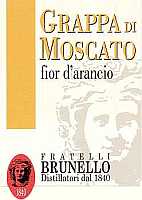
|
|
Grappa di Moscato Fior d'Arancio 2003 |
|
| Fratelli Brunello (Italy) | |
| Raw matter: Pomace of Muscat Blanc Fior d'Arancio | |
| Price: € 15.50 - 50cl | Score: |
| The grappa is colorless, limpid and crystalline. The nose reveals very intense, clean, pleasing and refined aromas of grape, apricot, rose, candied fruit, orange peel, hazelnut, lavender and apple with almost imperceptible alcohol pungency. In the mouth is intense with evident alcohol pungency that tends to dissolve rapidly, good balanced sweet hint and pleasing smoothness. The finish is very persistent with pleasing flavors of grape, orange peel and apple. A well made grappa produced with a discontinuous steam operated alembic still. Alcohol 43%. | |
Wine Parade |
|
|
| The best 15 wines according to DiWineTaste's readers. To express your best three wines send us an E-mail or fill in the form available at our WEB site. |
| Rank | Wine, Producer | |
|---|---|---|
| 1 |
| Riesling Cuvée Frédéric Emile 1999, Maison Trimbach (France) |
| 2 |
| Harmonium 2001, Firriato (Italy) |
| 3 |
| Chablis Grand Cru Les Clos 2002, Domaine Billaud-Simon (France) |
| 4 |
| Montepulciano d'Abruzzo Villa Gemma 1999, Masciarelli (Italy) |
| 5 |
| Jerez Fino Tio Pepe, Gonzalez Byass (Spain) |
| 6 |
| Pinot Noir Napa 2002, Clos du Val (USA) |
| 7 |
| Moscato d'Asti 2003, Vignaioli di S. Stefano (Italy) |
| 8 |
| Turriga 1998, Argiolas (Italy) |
| 9 |
| Amarone della Valpolicella Classico Capitel Monte Olmi 1999, Tedeschi (Italy) |
| 10 |
| Palazzo della Torre 2000, Allegrini (Italy) |
| 11 |
| Montepulciano d'Abruzzo Riparosso 2001, Illuminati (Italy) |
| 12 |
| Edizione Cinque Autoctoni 2001, Farnese (Italy) |
| 13 |
| Brunello di Montalcino Prime Donne 1998, Donatella Cinelli Colombini (Italy) |
| 14 |
| Aglianico del Vulture La Firma 2002, Cantine del Notaio (Italy) |
| 15 |
| Amarone della Valpolicella Classico 1998, Santa Sofia (Italy) |
| |||||||
Privacy Policy | |||||||


| Copyright © 2002-2024 Antonello Biancalana, DiWineTaste - All rights reserved |
| All rights reserved under international copyright conventions. No part of this publication and of this WEB site may be
reproduced or utilized in any form or by any means, electronic or mechanical, without permission in writing from DiWineTaste. |